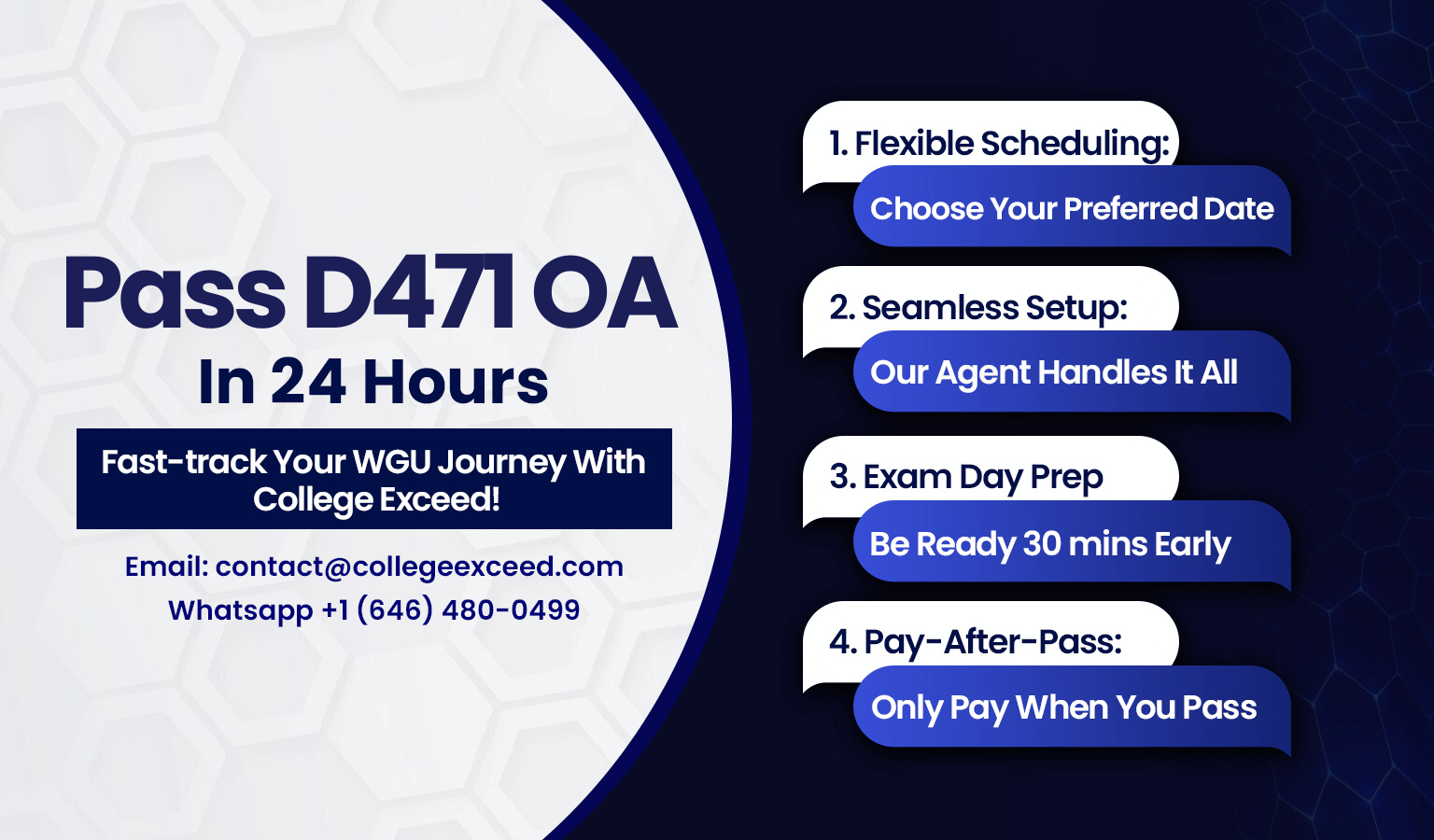WGU D471 OA Study Guide II - 2025 | Mastering Supply Chain Efficiency📖
If supply chains had a dating profile, their bio would probably read something like this: “Highly efficient, always optimizing, looking for ways to cut costs and boost performance.” But in reality, managing a supply chain isn’t always smooth sailing. Supply chain management requires companies to choose between outsourcing and offshoring operations as well as evaluate KPIs while deploying Six Sigma and the DMAIC process for efficiency and quality implementation.
Businesses in Global Supply Chain Management dedicate their continuous efforts to maintain product movement delivery success and customer satisfaction. This paper presents three fundamental components required for supply chain achievement:
- Outsourcing vs. Offshoring: Should a company delegate tasks to third parties or move entire operations overseas? The answer is more complicated than you think.
- Key Performance Indicators (KPIs): Numbers don’t lie! From inventory turnover to delivery performance, we’ll explore how businesses measure supply chain success.
- Six Sigma and DMAIC: Ever wondered how companies achieve near-perfect efficiency? We’ll dive into the Define, Measure, Analyze, Improve, and Control (DMAIC) process and how it helps businesses streamline operations.
When you finish reviewing this text you will grasp the concepts fully while getting a full view of their combined power that generates business profitability and operational resilience. The comprehensive explanation in this guide will deliver essential supply chain strategy knowledge to both WGU D471 OA students and anyone interested in the subject. Let’s get started!
How to Use This Guide for the WGU D471 OA Exam?📖
The D471 Global Supply Chain Management OA exam at WGU evaluates your understanding of supply chain strategies, performance metrics, and process improvement methodologies. This guide simplifies the key concepts of supply chain strategies (outsourcing vs. offshoring), key performance indicators (KPIs) in supply chain management (inventory turnover, order cycle time, fill rate, and delivery performance), and Six Sigma and the DMAIC process to help you grasp the topics tested in the exam.
We also provide exam-style questions and practical applications to ensure you’re fully prepared for the questions on the WGU D471 OA exam.

Supply Chain Strategies: Outsourcing vs. Offshoring For D471 OA📝
In today’s interconnected world, businesses must make strategic decisions on managing their supply chains efficiently. Two widely used strategies are outsourcing and offshoring. While they are often confused, they have distinct meanings and business implications. This article will break down these concepts step by step to provide a clear understanding.

Understanding Outsourcing
Organizations elect to outsource particular business tasks to another firm or third-party vendor that handles administrative responsibilities. The external provider works either from within the country or from abroad. Companies perform outsourcing transactions to cut expenses obtain professional abilities and enhance operational performance.
Through outsourcing companies redirect their attention toward essential business operations because non-core responsibilities fall to external experts. The business approach can be frequently observed in technological sectors together with manufacturing operations and customer service institutions.
Technology firms send customer service work to external call centers but retail operations use logistics services and fashion brands have their clothing made by outside manufacturers.
Understanding Offshoring
A business moves its full operations or services to another foreign country through offshoring. A business can reach offshoring goals through two approaches which require either establishing foreign facilities or partnering with local providers. Companies offshoring business procedures to global locations because it provides them with reduced expenses while accessing different workforce segments together with beneficial tax arrangements.
Organizations offshoring their operations have established factories in foreign sites to obtain reduced labor costs thereby a car producer builds plants in lower-cost locations while software developers relocate coding teams to nations with skilled tech professionals and clothing manufacturers conduct manufacturing outside their original base to save expenses.
Key Differences Between Outsourcing and Offshoring
Although outsourcing and offshoring share similarities, they have key differences:
Feature | Outsourcing | Offshoring |
Location | Can be domestic or international | Always involves another country |
Nature of Work | Specific tasks or services assigned to an external company | Entire business processes relocated |
Control | Less control over outsourced tasks | More control if offshored within company-owned facilities |
Goal | Access expertise and reduce costs | Lower labor costs and expand global presence |
Why Companies Outsource
Outsourcing helps businesses in multiple ways:
- Cost Savings: The costs of using external service providers usually prove less than the expenses of maintaining internal personnel.
- Focus on Core Business: The main business activities stay in focus because businesses transmit nonessential operations to external providers.
- Access to Expertise: Third-party vendors bring specialized knowledge and skills.
- Scalability: Outsourcing allows businesses to adjust services based on market demand.
- Improved Efficiency: Professionals handling outsourced tasks often complete them faster and better.
Why Companies Offshore
Offshoring offers distinct advantages:
- Lower Labor Costs: Businesses can reduce expenses by relocating operations to countries with lower wages.
- Increased Production Capacity: A larger workforce enables expansion.
- Global Market Access: Having a presence in a foreign country can facilitate entry into new markets.
- Tax and Regulatory Benefits: Some countries provide tax incentives for foreign businesses.
Challenges of Outsourcing and Offshoring
Despite the benefits, both strategies come with risks.
Challenges of Outsourcing
- Loss of Control: External vendors manage outsourced tasks, limiting direct oversight.
- Quality Concerns: The vendor may not meet expected quality standards.
- Dependency on Third Parties: Businesses become reliant on external providers.
- Communication Barriers: Cultural and time zone differences can lead to misunderstandings.
Challenges of Offshoring
- Cultural and Language Barriers: Managing teams in different regions can be complex.
- Political and Economic Risks: Some countries have unstable business environments.
- Time Zone Differences: Coordination across time zones can pose challenges.
- Supply Chain Complexity: Managing international logistics requires careful planning.
Balancing Insourcing, Outsourcing, and Offshoring
Businesses must carefully evaluate when to outsource, offshore, or keep tasks in-house. Strategies for achieving the right balance include:
- Assessing Core Competencies: Businesses should keep critical operations in-house while outsourcing non-core functions.
- Comparing Costs and Benefits: Companies should weigh the savings against the risks of outsourcing and offshoring.
- Using a Hybrid Approach: Many companies adopt a mix of insourcing, outsourcing, and offshoring.
- Monitoring Partnerships Closely: Performance tracking ensures vendors maintain expected quality levels.
- Staying Flexible: As markets evolve, businesses must adapt their strategies accordingly.
Importance For the D471 OA
The comprehension of outsourcing and offshoring processes became critical for organizations performing global supply chain management. Organizations need to inspect their business requirements together with possible risks and plan their strategic direction before choosing their initiative. A business should pick between outsourcing or offshoring or implement both so long as the results maintain high quality and operational efficiency levels and market competitiveness.
Students who master the taught strategies at WGU D471 will be better equipped to examine and enhance supply chain operations during real-world professional scenarios.
The overview of strategic supply chain decisions through outsourcing along with offshoring has us ready to understand key performance indicators (KPIs) that optimize supply chain efficiency measurements for businesses.
Key Performance Indicators (KPIs) in Supply Chain Management For D471 OA📝

Businesses need key performance indicators (KPIs) to efficiently operate their supply chains because KPIs help them assess operational efficiency and monitor development while spotting neglect opportunities. The supply chain’s general performance stands visible through these KPIs that enable organizations to make educated choices. The following section discusses vital supply chain KPIs consisting of Inventory Turnover alongside Order Cycle Time and Fill Rate alongside Delivery Performance.
Understanding KPIs in Supply Chain Management
A well-managed supply chain ensures that products move efficiently from suppliers to customers. KPIs serve as measurable benchmarks that help businesses analyze supply chain effectiveness. Each KPI focuses on a different aspect of supply chain performance and plays a crucial role in maintaining smooth operations.
1. Inventory Turnover
A company obtains its inventory turnover ratio through accounting for inventory replacement cycles within a designated time frame. The measure indicates how well inventory management functions.
Why is Inventory Turnover Important?
- A high turnover rate suggests strong sales and efficient inventory management.
- A low turnover rate may indicate overstocking, slow sales, or excess capital tied up in inventory.
- Helps businesses optimize their stock levels and reduce storage costs.
- Impacts cash flow since slow-moving inventory can tie up financial resources.
How to Calculate Inventory Turnover:
Formula:
A higher inventory turnover ratio generally means a company is selling products quickly, reducing the risk of obsolescence and excess stock.
2. Order Cycle Time
The duration between a customer placing an order and product delivery makes up order cycle time. Supply chain efficiency and customer satisfaction experience a negative impact due to this factor.
Why is Order Cycle Time Important?
- Shorter order cycle times improve customer satisfaction and competitiveness.
- Helps companies identify delays in processing, production, or shipping.
- Allows businesses to optimize workflows and improve responsiveness.
Factors Affecting Order Cycle Time:
- Efficiency of order processing and fulfillment systems.
- Inventory availability and warehouse management.
- Shipping and transportation speed.
- Communication across different supply chain departments.
3. Fill Rate
The measurement for fill rate calculates the complete order fulfillment percentage alongside on-time delivery for customers. The measure provides vital insights into both inventory management effectiveness and customer demand fulfillment abilities of a business.
Why is Fill Rate Important?
- A high fill rate means strong inventory management and efficient fulfillment processes.
- A low fill rate can indicate supply chain inefficiencies, forecasting errors, or stockouts.
- Directly impacts customer retention and satisfaction.
Types of Fill Rate:
- Order Fill Rate: Percentage of orders fulfilled completely.
- Line Fill Rate: Percentage of order lines filled from available inventory.
- Unit Fill Rate: Percentage of individual items delivered compared to items ordered.
Formula:
A higher fill rate reflects a well-optimized supply chain with minimal disruptions.
4. Delivery Performance
The evaluation of delivery performance includes rating a company’s ability to meet its delivery requirements for both timely fulfillment and precise order completion.
Why is Delivery Performance Important?
- Directly influences customer satisfaction and brand reputation.
- Helps measure the reliability of suppliers and logistics partners.
- Identifies areas where delivery processes need improvement.
Factors Affecting Delivery Performance:
- Transportation efficiency (delays, route optimization, carrier performance).
- Warehouse operations (picking, packing, and dispatching speed).
- Weather and external disruptions affecting supply chain flow.
- Supplier reliability and adherence to service-level agreements (SLAs).
Tracking and Improving Supply Chain KPIs
To optimize supply chain performance, businesses must regularly monitor KPIs and implement improvements.
Best Practices for KPI Optimization:
- Utilize real-time tracking systems for inventory and shipments.
- Automate order processing to reduce cycle time.
- Work with reliable logistics partners to enhance delivery efficiency.
- Improve demand forecasting to minimize stockouts and overstocking.
- Leverage technology, such as ERP and warehouse management systems, for better control.
Importance For the D471 OA
Supply chain management success metrics called Key Performance Indicators (KPIs) let businesses assess performance while improving operational effectiveness and preserving customer satisfaction. Businesses can achieve operational excellence while gaining market advantages by analyzing inventory turnover together with order cycle time fill rate and delivery performance. Business profitability and customer loyalty become enhanced through the delivery of a seamless production-to-delivery supply chain process that benefits from proper monitoring.
A successful application of these KPIs by WGU D471 students allows them to analyze and improve supply chain strategies when working in real business environments.
We have finished our discussion on supply chain management KPIs so we will examine the effective business methodologies of Six Sigma with its DMAIC process for enhancing both efficiency and quality standards.
Tired of reading blog articles?
Let’s Watch Our Free WGU D471 Practice Questions Video Below!

Six Sigma and the DMAIC Process For D471 OA📖
Modern business competition demands perpetual process enhancement from organizations because it helps reduce waste creates operational efficiency and maintains high-quality output delivery. Businesses can achieve their minimum defect methodology goals by using Six Sigma which operates as a data-based operation optimization framework. Organizations find their path for process improvement through the structured DMAIC process which represents the basic foundation of Six Sigma.
What is Six Sigma?
Six Sigma functions as an organizational quality management system devoted to lowering process defects and raising company-wide performance levels. The target outcome for Six Sigma execution lies in achieving 3.4 defects per million opportunities (DPMO) to establish an almost flawless process operation. Organizations that adopt Six Sigma achieve competitive advantages through enhanced client satisfaction together with operational effectiveness while saving money. Applications of this methodology exist in many manufacturing institutions healthcare organizations financial services and retail businesses while they work to enhance their operations and decrease waste generation.
Understanding the DMAIC Process
Six Sigma functions through its essential DMAIC method which stands for Define, Measure, Analyze, Improve, and Control. The method gives organizations a methodical way to tackle problems while enhancing their operational sequences. The following sections analyze each phase individually.
1. Define
The first phase of DMAIC focuses on defining the problem and setting clear objectives for improvement.
- Identify the process or problem that requires improvement.
- Set specific, measurable goals.
- Understand customer expectations and map out the value stream.
Businesses must now examine both the project’s boundaries and limitations to confirm alignment with corporate goals.
2. Measure
The Measure phase is all about collecting relevant data to assess the current state of the process.
- Establish baseline performance metrics.
- Identify key performance indicators (KPIs) related to the issue.
- Use statistical tools to evaluate variations and defects.
Accurate data collection is essential in this phase, as it provides a benchmark for measuring progress and identifying areas of concern.
3. Analyze
This phase involves identifying the root causes of inefficiencies.
- Perform Root Cause Analysis (RCA) to pinpoint underlying issues.
- Utilize tools such as Failure Mode and Effects Analysis (FMEA) to assess risks.
- Identify patterns, process bottlenecks, and inefficiencies.
Businesses who examine their data with precision will discover actual performance deterioration causes which leads them to create selected solutions.
4. Improve
Once the root causes are identified, the focus shifts to implementing improvements.
- Develop and test potential solutions.
- Apply Kaizen events and Design of Experiments (DOE) for optimization.
- Conduct pilot tests before full-scale implementation.
The improvement phase is where real changes take place. Companies refine processes, implement innovative solutions, and ensure that improvements lead to measurable success.
5. Control
The final phase ensures that improvements are maintained over time.
- Establish monitoring systems to track performance.
- Use Statistical Process Control (SPC) to detect variations.
- Develop standard operating procedures (SOPs) to sustain efficiency.
Maintaining consistency is crucial in this phase, as it prevents regression and ensures long-term success.
Benefits of Six Sigma and DMAIC
Organizations can obtain multiple advantages by implementing Six Sigma together with DMAIC throughout their diverse industries:
1. Cost Savings and Waste Reduction
By eliminating inefficiencies, Six Sigma reduces operational costs and minimizes the waste of time, resources, and materials.
2. Improved Efficiency and Productivity
Streamlined processes lead to faster production cycles, fewer errors, and better resource utilization.
3. Enhanced Customer Satisfaction
A focus on quality ensures that customers receive defect-free products and services, increasing brand loyalty and reputation.
4. Employee Engagement and Skill Development
Six Sigma promotes a culture of continuous improvement, encouraging employees to participate in problem-solving initiatives and develop analytical skills.
5. Competitive Advantage
Organizations that implement Six Sigma gain a competitive edge by delivering high-quality products and services efficiently.
Importance For the D471 OA
Six Sigma uses the DMAIC process to give organizations a systematic data-based approach that enhances managerial operations across their business systems. Company efficiency and cost reduction along with quality improvement happens through problem definition followed by metric measurement and efficiency analysis and solution implementation and control maintenance. Understanding and applying Six Sigma principles will equip students of WGU D471 with valuable skills to enhance supply chain management and drive business success.

Final Thoughts: Mastering WGU D471 OA for Supply Chain Excellence📖
Congratulations! You’ve made it through an essential breakdown of outsourcing, KPIs, and Six Sigma. These concepts are not just theoretical; they are critical for optimizing real-world supply chains. Understanding when to outsource or offshore, how to track performance with KPIs, and how to enhance efficiency using Six Sigma and DMAIC will give you the knowledge and confidence needed in supply chain management.
Memorize these subjects thoroughly because they will definitely appear in the WGU D471 OA assessment. Spend time studying core points in combination with understanding their real-world applications by practicing business scenarios in which these strategies become active.
Your success in WGU D471 depends on the preparation work you complete that will help you both master the final test and use these concepts confidently. All the best to you for your WGU D471 OA exam because you are destined for success.






